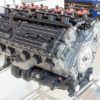When you think of Porsche, you probably imagine sleek sports cars with powerful engines. But have you ever wondered if Porsche has ever made a V12 engine? Let’s explore the history of Porsche’s engine lineup to find out.
Porsche is known for its iconic flat-six engines, which have powered many of their most famous models. However, throughout their history, Porsche has never produced a production car with a V12 engine. This is largely due to their commitment to the design principles that have made their cars so successful: lightweight construction, excellent handling, and a focus on driver experience.
Instead of V12 engines, Porsche has focused on developing and refining their own unique flat engines, including the legendary flat-six. This engine configuration offers several advantages over a V12, including a lower center of gravity, better weight distribution, and improved handling. These characteristics have helped Porsche cars achieve exceptional performance on the track and on the road.
That being said, Porsche has not completely shied away from larger engines. In recent years, they have introduced a range of models with V8 engines, such as the Panamera and the Cayenne. These engines provide the power and performance that Porsche enthusiasts crave, while still maintaining the brand’s signature driving characteristics.
In conclusion, while Porsche has never produced a production car with a V12 engine, they have instead focused on perfecting their own unique flat engine designs. This commitment to innovation and performance has made Porsche one of the most respected and revered automotive brands in the world.
Has Porsche Ever Made a V12?
No, Porsche has never produced a V12 engine for its production cars. The German automaker is well-known for its iconic flat-six engines, which have been a staple of the brand’s lineup for decades. However, Porsche has experimented with various engine configurations throughout its history, including V8 engines.
Porsche’s decision to stick with flat-six engines is rooted in their commitment to the brand’s signature handling characteristics. The flat-six layout allows for a lower center of gravity, which enhances the car’s balance and agility. This design philosophy has been a key factor in Porsche’s success on both the road and the track.
While Porsche has not produced a V12 engine for its road cars, the company did develop a V12 engine for its 917 race car in the 1970s. The Porsche 917 is one of the most successful and iconic race cars in history, winning numerous championships and endurance races, including the 24 Hours of Le Mans. The V12 engine used in the 917 was a 4.5-liter unit that produced up to 600 horsepower.
In recent years, Porsche has focused on hybrid technology and electrification, with models like the Porsche 918 Spyder and the Taycan electric sedan. These vehicles feature hybrid powertrains and electric motors, further demonstrating Porsche’s commitment to innovation and sustainability.
While Porsche may not have a V12 engine in its lineup, the brand’s dedication to performance and engineering excellence is evident in every car they produce. Whether it’s a classic 911 with its iconic flat-six engine or a cutting-edge electric sports car, Porsche continues to push the boundaries of automotive technology.
Exploring the History of Porsche’s Engine Lineup
Over the years, Porsche has developed a rich and diverse lineup of engines that have powered their iconic sports cars. From the early days of the company to the present, Porsche has constantly pushed the boundaries of automotive engineering, delivering powerful and efficient engines that have become the heart and soul of their vehicles.
One of the most notable engines in Porsche’s history is the flat-six engine, which has been a staple of the brand since the 1960s. This horizontally-opposed engine configuration provides a low center of gravity and excellent balance, delivering smooth power and precise handling. The flat-six has been used in numerous Porsche models, including the legendary 911 and Boxster.
In addition to the flat-six, Porsche has also experimented with other engine types throughout its history. One such example is the V8 engine, which was introduced in the mid-1970s. This engine offered increased power and torque compared to the flat-six, making it suitable for larger and more luxurious Porsche models like the Panamera and Cayenne.
Porsche has also dabbled in turbocharging, with the introduction of the turbocharged flat-six engine in the 1970s. This innovative engine technology provided a significant boost in power and performance, making Porsche cars even more thrilling to drive. Turbocharging has since become a signature feature of many Porsche models, including the 911 Turbo.
Furthermore, Porsche has embraced hybrid technology in recent years, combining electric motors with traditional gasoline engines to create powerful and efficient hybrid powertrains. This approach has allowed Porsche to maintain its performance heritage while also reducing emissions and improving fuel economy. The Porsche Panamera S E-Hybrid and the Porsche 918 Spyder are prime examples of Porsche’s commitment to sustainable performance.
In conclusion, Porsche’s engine lineup is a testament to the brand’s dedication to innovation and performance. From the iconic flat-six engine to the introduction of turbocharging and hybrid technology, Porsche has continually pushed the boundaries of automotive engineering. Whether it’s on the racetrack or the open road, Porsche’s engines have always been at the forefront of performance and excitement.
Early Years: The Birth of the Porsche Engine
When discussing the history of Porsche’s engine lineup, it is important to start at the beginning. In the early years of the company, Ferdinand Porsche was primarily focused on designing and producing automobiles for other manufacturers. It wasn’t until 1948 that the first Porsche-branded car, the Porsche 356, was introduced to the world. Along with this new car came the birth of the Porsche engine.
The first Porsche engine, known as the Type 356/2, was a four-cylinder air-cooled engine. This engine was a flat-four design, meaning the cylinders were horizontally opposed, which was a design characteristic that would become synonymous with Porsche. The engine had a displacement of 1.1 liters and produced around 35 horsepower. While this may not seem like much by today’s standards, it was a respectable amount of power for a small car like the 356.
One of the key features of the Porsche engine was its compact size and lightweight construction. This allowed it to be mounted in the rear of the car, which had several advantages. By placing the engine at the rear, Porsche was able to achieve better weight distribution, which improved the car’s handling and overall performance. Additionally, the rear-mounted engine reduced the amount of noise and vibration that made its way into the cockpit, creating a more enjoyable driving experience.
Over the years, Porsche continued to refine and improve its engine designs. The company introduced larger displacement engines, such as the 2.0-liter flat-six found in the Porsche 911, which offered increased power and torque. Porsche also embraced technology advancements, such as fuel injection and turbocharging, to further enhance the performance of its engines.
In conclusion, the early years of Porsche’s engine lineup were characterized by the development of the flat-four engine and the introduction of the rear-mounted engine layout. These innovations laid the foundation for the iconic Porsche driving experience that enthusiasts around the world still enjoy today.
Evolution of the Porsche Engine Lineup
The Porsche brand has a rich history of engineering excellence, and its engine lineup has evolved significantly over the years. From its early days as a manufacturer of sports cars to its current lineup of high-performance vehicles, Porsche has continually pushed the boundaries of automotive engineering.
One of the key milestones in the evolution of the Porsche engine lineup was the introduction of the flat-six engine. This iconic engine configuration has been a mainstay of Porsche vehicles for decades and is known for its smooth power delivery and distinctive sound. The flat-six engine has undergone several iterations and improvements over the years, with advancements in technology and materials leading to increased performance and efficiency.
In addition to the flat-six engines, Porsche has also developed a range of other engine configurations to meet the demands of different vehicle models and market segments. The flat-four engine, for example, was introduced in the Porsche 912 and later used in the 914 and 924 models. This compact engine design offered a balance of performance and fuel efficiency, making it popular among enthusiasts.
As Porsche expanded its lineup to include SUVs and sedans, it also introduced V6 and V8 engines to power these larger vehicles. These engines provided the necessary power and torque to propel the heavier vehicles while maintaining the dynamic driving characteristics that Porsche is known for. The V6 and V8 engines have been continuously refined and optimized to deliver impressive performance and fuel economy.
In recent years, Porsche has embraced hybrid and electric technology, further expanding its engine lineup. The introduction of hybrid powertrains in models like the Panamera and Cayenne has allowed Porsche to combine the efficiency of electric motors with the performance of gasoline engines. Meanwhile, the all-electric Porsche Taycan represents a new era for the brand, showcasing the potential of electric propulsion in high-performance vehicles.
Overall, the evolution of the Porsche engine lineup is a testament to the brand’s commitment to innovation and performance. From the iconic flat-six engines to the latest hybrid and electric powertrains, Porsche continues to push the boundaries of what is possible in automotive engineering.












